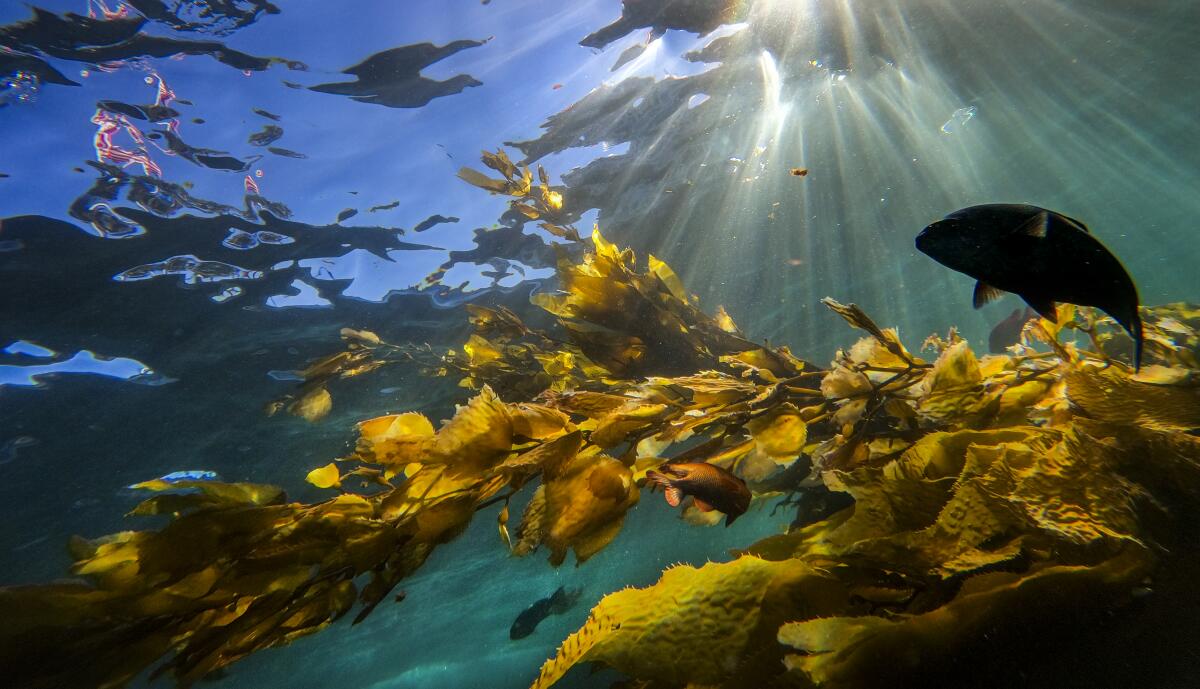Newsletter: Essential California: A toxic undersea dumping ground

Good morning, and welcome to the Essential California newsletter. It’s Tuesday, Oct. 27, and I’m writing from Los Angeles.
Sign up for Essential California
The most important California stories and recommendations in your inbox every morning.
You may occasionally receive promotional content from the Los Angeles Times.
Certain environmental threats are impossible to ignore here in California.
You don’t need to read a 3,000-word explainer to grasp the urgency of wildfires when you’ve personally packed a go-bag. And the inability to open your windows for weeks on end has probably made you more attuned to the effects of air quality issues than any multipart investigation ever could.
But there are plenty of other threats that have yet to commandeer space in our daily lives, and still feel abstract to most Californians. As an environment reporter, my colleague Rosanna Xia specializes in taking on those issues and talking about them in a way that feels tangible and immediate. She spins reams of research and months of reporting into sweeping narratives, and synthesizes academic complexities into easily digestible explanations.
Last year, Rosanna wrote about the future of the California coast as sea levels rise and the difficult choices ahead. The story was a Pulitzer Prize finalist.
Rosanna just published a new and equally critical story that unravels a toxic mystery on the California coast. She recounts how the waters off Catalina became a dumping ground for a now-banned pesticide — a toxic legacy that remained hidden until a new generation of scientists discovered the evidence.
[Read the story: “How the waters off Catalina became a DDT dumping ground” in the Los Angeles Times]
I asked Rosanna to give newsletter readers an introduction to her new investigation and tell us more about how it came about. Here’s what she had to say:
As an environment reporter covering our coast and ocean, I often think about the problems of our future: Communities at risk of flooding, animals on the cusp of extinction, the unimaginable amount of plastic accumulating in the sea. But for my most recent article, I found myself digging through the past — unraveling a toxic mystery that had been buried for decades.
Remember DDT, the all-but-indestructible pesticide that first stunned the public and ignited the environmental movement in the 1960s? The chemical was so powerful it poisoned fish, wiped out bald eagles and afflicted generations of women with the still mysterious risks of breast cancer. Many Californians today are surprised to learn that the nation’s largest DDT manufacturer was right here in Los Angeles. For those who lived through the epic Superfund battle in the 1990s, you might recall the outcry when we first learned that the company disposed hundreds of tons of DDT through sewage pipes that poured into the ocean.
But there was another chapter to this horrific saga that remained largely unknown: In the years after World War II, DDT waste was also quietly boated out to sea, where workers would dump barrels of this stuff not far from Santa Catalina Island. As many as half a million barrels, according to records and studies, could still be underwater today.
This dumping was so hard to prove at the time that people eventually moved on. But as one scientist recently told me: The problems we try to forget don’t just go away. They eventually come back to haunt us.
So after a “holy crap” phone call from a source last year, I pulled out my copy of “Silent Spring” and re-read the words that shook the world in 1962. “If we are going to live so intimately with these chemicals,” Rachel Carson wrote, “eating and drinking them, taking them into the very marrow of our bones — we had better know something about their nature and their power.”
“The obligation to endure,” she added, quoting biologists who came before her, “gives us the right to know.”
I thought of this right to know as I tracked down old records, depositions and articles that could piece together what we did to the ocean all those years ago. I flipped through shipping logs from the 1950s that documented all the cyanide, acid sludge and other waste that were dumped into the sea. I ran out of sticky notes as I bookmarked what felt like every page in out-of-print textbooks on ocean dumping. A number of studies that were cited didn’t seem to exist in digital archives, so I got out the phone books and tried calling the authors.
I’m so grateful to all the researchers, then and now, who picked up and went to great lengths to help answer my questions. One scientist offered to dig up everything he still had in storage — stacks of yellowing papers he had held on to for all these years. We hunkered down for two days last fall, coffee mugs and documents sprawled out on the floor as we re-read scientific findings from the 1980s that still resonate today.
Dilution is the solution to pollution, the saying used to go, but at what cost? As we increasingly look to the ocean to solve our carbon problems, our trash problems, our health and food problems, we must first understand how much we’ve already abused this natural resource that connects us all. What are the forgotten lessons that we must relearn — and ultimately resolve — in order to have a shot at a better future?
It’s been a journey piecing together all the information that I present to you now. I’ll end with one more thought from Rachel Carson, who penned these words more than 50 years ago:
“We stand now where two roads diverge. But unlike the roads in Robert Frost’s familiar poem, they are not equally fair. The road we have long been traveling is deceptively easy, a smooth superhighway on which we progress with great speed, but at its end lies disaster. The other fork of the road — the one less traveled by — offers our last, our only chance to reach a destination that assures the preservation of the earth.”
[Read the story: “How the waters off Catalina became a DDT dumping ground” in the Los Angeles Times]
And now, here’s what’s happening across California:
Orange County was under siege Monday from two wind-driven brush fires that forced 90,000 people from their homes, critically injuring two firefighters and leaving many others on edge. The Silverado fire in Irvine broke out shortly after 6:45 a.m. near Santiago Canyon and Silverado Canyon roads, burning in a hilly area above homes. A second fire burned one home and threatened hundreds of others in Yorba Linda north of the 91 Freeway. Los Angeles Times
[See also: A map of fires burning in California from the Los Angeles Times]
Meanwhile, fears of calamitous wind-sparked fires in Northern California were averted Monday, but desert-like low humidity means that the Bay Area will remain under a red flag warning at least through Tuesday afternoon. San Francisco Chronicle
Note: Some of the sites we link to may limit the number of stories you can access without subscribing.
L.A. STORIES
L.A. County supervisors will consider a motion seeking options to remove Sheriff Villanueva on Tuesday. In recent weeks, the L.A. County sheriff has faced growing calls to step down because of what many describe as his resistance to oversight and transparency. Los Angeles Times
“How learning to roller skate helped me connect with a piece of L.A. Black culture.” Arts reporter Makeda Easter on her pandemic hobby of choice, and L.A.’s long, rich history of roller skater culture. Los Angeles Times
The man behind “Selena: The Series” is ready to lead Hollywood’s Latinx revolution. Producer Jaime Dávila has been on a mission to get Hollywood’s gatekeepers to abandon their outdated perceptions of the Latinx market. Los Angeles Times
The Facebook group that’s helping keep San Gabriel Valley mom-and-pop restaurants alive. Created by two Valley natives, the “SGV Eats” group serves as a virtual gathering space for restaurant owners and foodies alike. L.A. Taco
Support our journalism
POLITICS AND GOVERNMENT
The Senate confirmed Judge Amy Coney Barrett to the Supreme Court on Monday in the most partisan confirmation vote for a justice in modern American history, securing a 6-3 conservative majority widely expected to expand gun rights and permit new restrictions on abortion. Los Angeles Times

HEALTH AND THE ENVIRONMENT
The strongest Santa Ana winds of the year brought unhealthful air quality to parts of the Los Angeles Basin and San Gabriel Valley as ash from the nearly contained Bobcat fire blew into neighborhoods. Los Angeles Times
CALIFORNIA CULTURE
America’s oldest children’s bookstore is struggling in the pandemic. But there’s hope. Los Angeles Times
Many California farmworkers fear a winter of hunger and homelessness amid the pandemic. Although farmworkers in the U.S. illegally have been declared essential for the state’s multibillion-dollar agriculture industry, they often don’t qualify for safety nets such as unemployment, eviction moratoriums or stimulus aid that have become lifelines for many as they weather a crushing year of disasters. Los Angeles Times
A survivor group slammed Fresno Catholic churches for withholding the names of priests credibly accused of sexual misconduct. Fresno Bee
A poem to start your Tuesday: “A Center” by Ha Jin. Poetry Foundation
Free online games
Get our free daily crossword puzzle, sudoku, word search and arcade games in our new game center at latimes.com/games.
CALIFORNIA ALMANAC
Los Angeles: sunny, 78. San Diego: sunny, 73. San Francisco: partly sunny, 75. San Jose: partly sunny, 78. Fresno: sunny, 73. Sacramento: sunny, 78. More weather is here.
AND FINALLY
Today’s California memory comes from Fumiko Li:
It was probably in the late-ish 1960s and I was a little girl all dressed up for a family outing to San Francisco to pick up something like sheet music for my older brother. All four kids, my father who must’ve found free parking because he had that gift, and my mother also all dressed up for a trip across the bay to the city. Walking in North Beach around Broadway, I watched a woman in a mini-dress and go-go boots climb up a telephone pole to the top where she danced to some kind of go-go music. I was in love.
If you have a memory or story about the Golden State, share it with us. (Please keep your story to 100 words.)
Please let us know what we can do to make this newsletter more useful to you. Send comments, complaints, ideas and unrelated book recommendations to Julia Wick. Follow her on Twitter @Sherlyholmes.
Sign up for Essential California
The most important California stories and recommendations in your inbox every morning.
You may occasionally receive promotional content from the Los Angeles Times.





